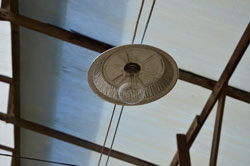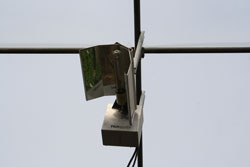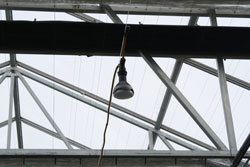3/26/2014
Managing Photoperiodic Lighting
Roberto G. Lopez & Christopher Currey

In greenhouse and nursery production, photoperiod can influence many aspects of plant growth and development, including dormancy, storage organ formation and—most importantly for many greenhouse producers—flowering. Many potted flowering and bedding plants, cut flowers and herbaceous perennials flower in response to
photoperiod.
Figure 1. An incandescent light bulb with an aluminum pie plate reflector is one of the most common—and easiest—strategies to provide photoperiodic lighting for your crops.
While we refer to photoperiod when discussing plant development, it’s actually the uninterrupted period of darkness that controls plant responses to day length. For most floriculture crops, a short day occurs when the night is at least 12 hours. For many long-day crops, a long day occurs when the night length is less than 10 hours, although this varies among species. Many annuals and perennials grown for spring sales are long-day crops and, as such, we need to use photoperiodic lighting to get these crops into flower (Figure 1). Alternatively, several important potted plants, such as chrysanthemums, kalanchoes and poinsettias, are short-day plants and photoperiodic lighting is used to keep these plants vegetative.
The natural photoperiod
In the northern hemisphere, day length increases between December 21 (the shortest day) until June 21 (the longest day), after which it decreases. Seasonal fluctuation in day length becomes more dramatic as the latitude increases. For example, the day length in New Orleans (30 degrees N latitude) ranges from around 11 hours to just over 14½ hours. Meanwhile, the day length in Minneapolis (45 degrees N latitude) ranges from 9½ to 16 hours. Because plants can perceive low light intensities, the natural (or biological) day length is approximately 30 to 40 minutes longer than the period from sunrise to sunset due to civil twilight.
To determine your natural photoperiod, first determine your day length using the local times for sunrise and sunset. Next, add approximately 30 to 40 minutes to account for civil twilight. This will help determine when you will need to use photoperiodic lighting and how to manage it.
 Using photoperiodic light to create long days
Using photoperiodic light to create long days
If your goal is to create a long day (LD) photoperiod, you may use day-extension or night-interruption photoperiodic lighting. Each method has advantages and disadvan-tages, but generally, they’re similarly effective. Both methods require you to deliver at least 10 foot candles (f.c.) or ~2 µmol·m−2·s−1 of light when measured at plant level.
Figure 2. A high-pressure sodium (HPS) lamp with an oscillating reflector is a newer technology used to provide photoperiodic, not supplemental, lighting to plants in the greenhouse.
Day-extension (DE) lighting is the practice of delivering light to extend the length of the natural day. The length of time you light will depend on the period of darkness the plant requires and the natural day length. For example, if the natural day length is nine hours and you desire a 14-hour photoperiod, you would keep the lights operating after dusk for about 5½ hours (an extra half-hour for “insurance” against sunset/dusk). When using low-intensity light (i.e. 10 f.c. or 2 µmol·m−2·s−1) to extend the day length, there’s really no additional photosynthetic or supplemental light being provided. However, many growers operate their HPS lamps in the evening and, depending on the light intensity and duration of operation, this can act as both photoperiodic and supplemental light.
Night interruption (NI) lighting, or “mum lighting,” is the practice of providing low-intensity photoperiodic lighting to plants during the middle of the night. By interrupting the dark period, the plant won’t perceive a long night, but a short night (i.e., long day) instead. NI lighting is typically delivered during the middle of the night (such as from 10:00 p.m. to 2:00 a.m.) because plants are most sensitive to light at this time.
Typically, four hours of NI lighting is sufficient for plants that demonstrate an LD response. Most growers provide continuous light during the NI process to ensure a long-day response. However, continuous light during the NI isn’t absolutely necessary for plants to perceive a long day.
Cyclic or intermittent lighting is an alternative lighting strategy that can reduce equipment and energy costs by reducing the number of ballasts and lamps and power consumption, respectively. Cyclical lighting involves using periodic lighting in the middle of the night, such as light on for five minutes every 20 minutes during a 4-hour period. Generally speaking, plants need to receive at least 10 f.c. (~2 µmol·m−2·s−1) for a minimum of five minutes every half hour. This may reduce the overall amount of energy required to elicit an LD response by up to 83%, although some crops may flower later compared to plants under continuous 4-hour lighting.
Lamp types/light sources
There are several options you have when looking at light sources for use in photoperiodic lighting, each with advantages and disadvantages.
Incandescent bulbs. These are commonly used in greenhouses to provide DE and/or NI lighting. Incandescent lights may be used for cyclic lighting because the frequent on-and-off won’t negatively affect bulb life or fixture longevity. Incandescent bulbs are inexpensive and emit an effective spectrum, but they’re very energy inefficient and require high power availability. Screw-in compact fluorescent lights (CFLs) are an attractive alternative to traditional incandescent lamps for DE and NI lighting. While CFLs are more energy-efficient and effective for use on many crops, their spectrum isn’t as effective at controlling flowering of some LD plants. CFLs are low in far-red (FR) light, which is required for rapid flowering of some LD crops, including pansy and petunia. One strategy to take advantage of the energy-saving CFL and the FR-rich incandescent bulb is to alternate CFL with incandescent bulbs in fixtures within the greenhouse. This will provide the required light quality for effective photoperiodic lighting and still achieve some energy
savings.
High-intensity discharge (HID) lamps. HID lamps, such as metal halide and HPS lamps, may also be used effectively. There are several ways to use these lamps to provide DE and NI lighting. Most commonly, HPS lamps are suspended above the crop. Another method is to mount HPS lamps on booms that move over the crop. The newest development in HPS lamps is to use an oscillating reflector (Figure 2). When using an HID lamp, such as HPS lamps for photoperiodic lighting, you may be providing supplemental or photosynthetic light as well, depending on the intensity of the light and the hours of operation. See the article in the March 2014 issue of GrowerTalks on supplemental lighting for more information.

Figure 3. Light-emitting diodes (LEDs) are a new technology with great promise for use in photoperiodic lighting.
Light-emitting diodes (LEDs). This technology is an emerging light source with promising plant applications, including the regulations of flowering (Figure 3). Their long lifespan, energy efficiency, and ability to target specific wavelengths of light make them a viable option for managing photoperiod. LEDs also provide the opportunity to adjust the ratio of red (R) and FR light for desired plant responses. The best combination of R/FR is being studied at Michigan State University, but we do know that far-red light is important in promoting flowering in LD plants. Currently, there are LED bulbs that are on the market for use in photoperiodic lighting that contain both R and FR and are being met with success in some greenhouses.
Conclusions
Managing the photoperiod is an important aspect of greenhouse environmental management. By understanding the natural photoperiod and the techniques used to manipulate photoperiod, you can achieve desired plant responses, such as accelerate flowering and reach target market dates more reliably. Hopefully, this two-part series has helped “shed some light” on the differences between supplemental and photoperiodic lighting so you can better achieve your goals in your greenhouse.
GT
Christopher Currey (ccurrey@iastate.edu) is an assistant professor in the Department of Horticulture at Iowa State University and Roberto Lopez (rglopez@purdue.edu) is an associate professor and Extension specialist in the Department of Horticulture and Landscape Architecture at Purdue University.